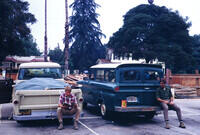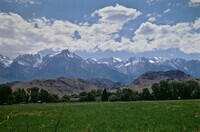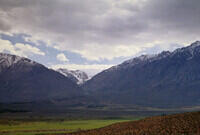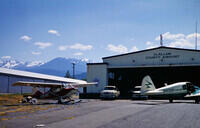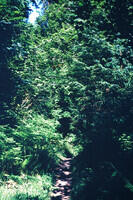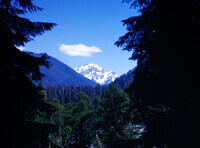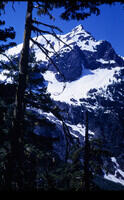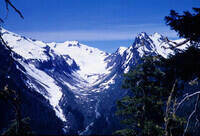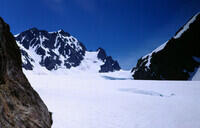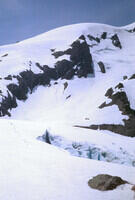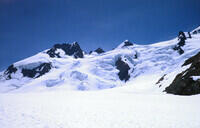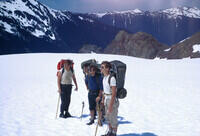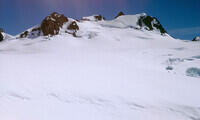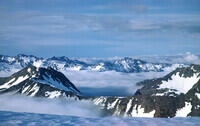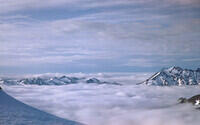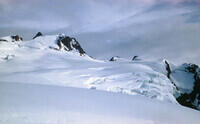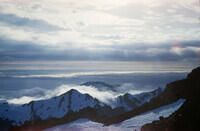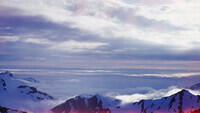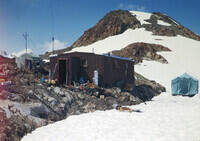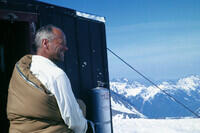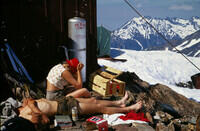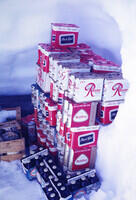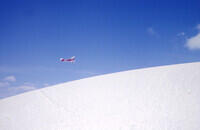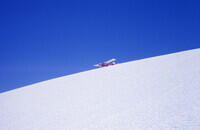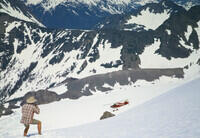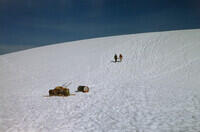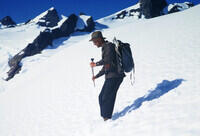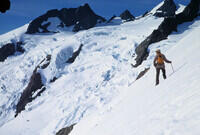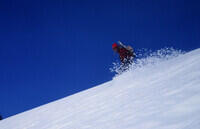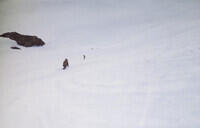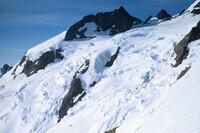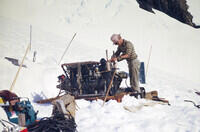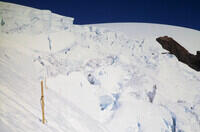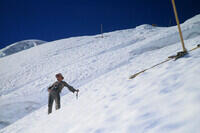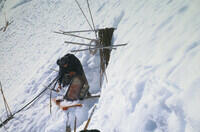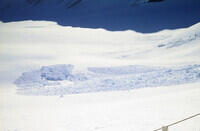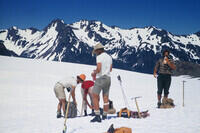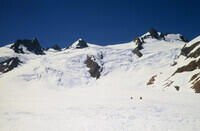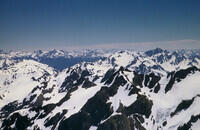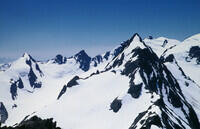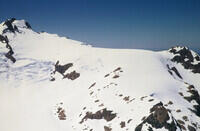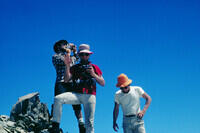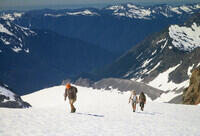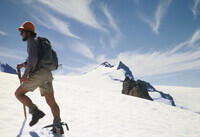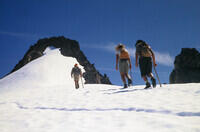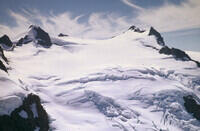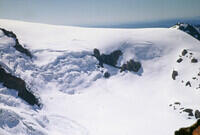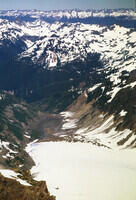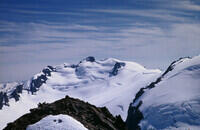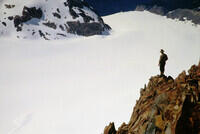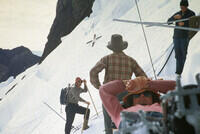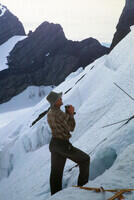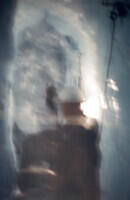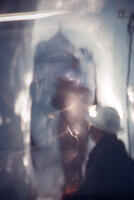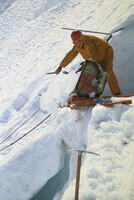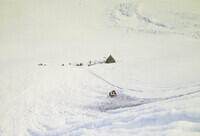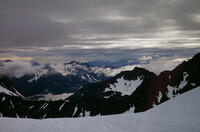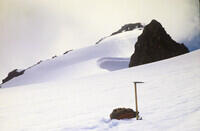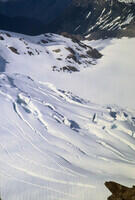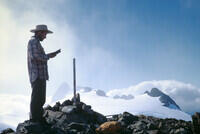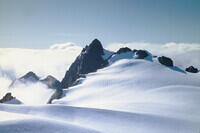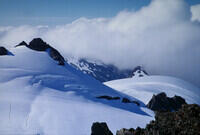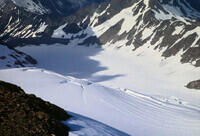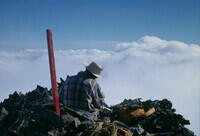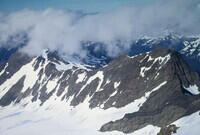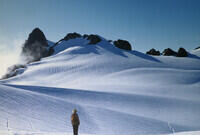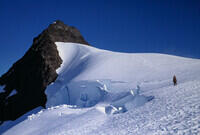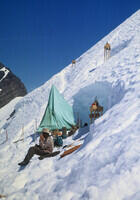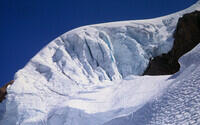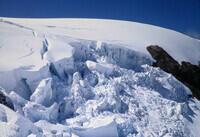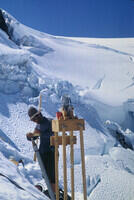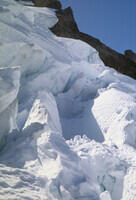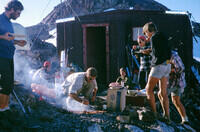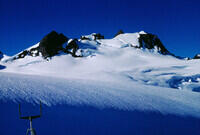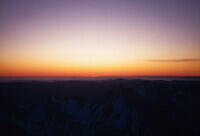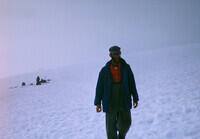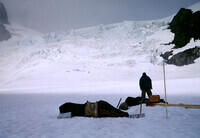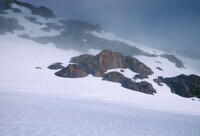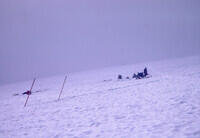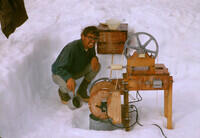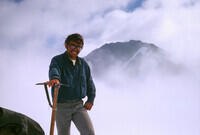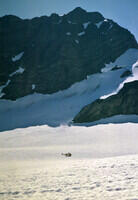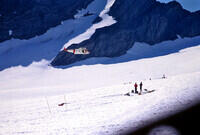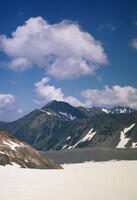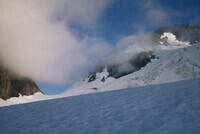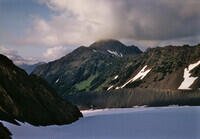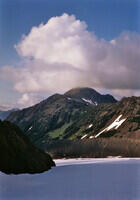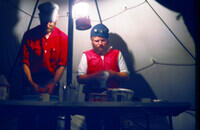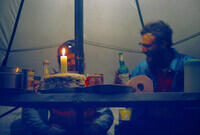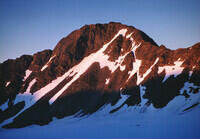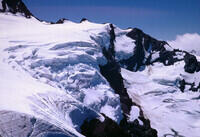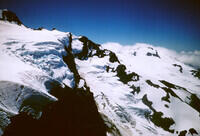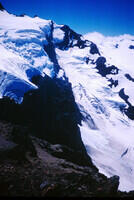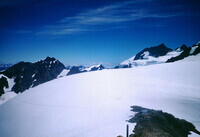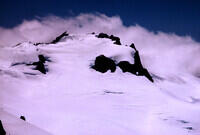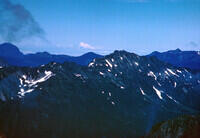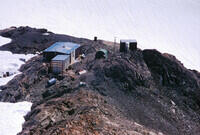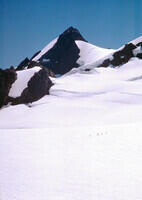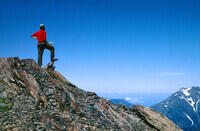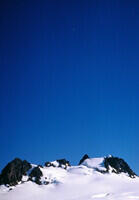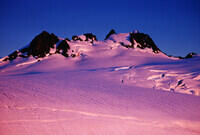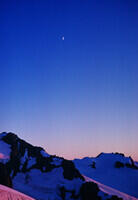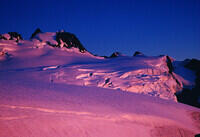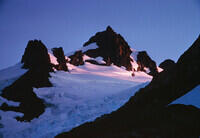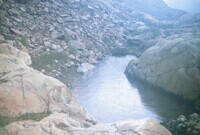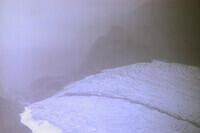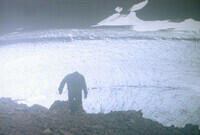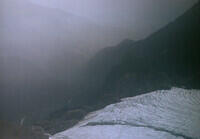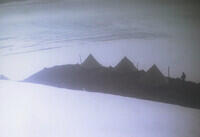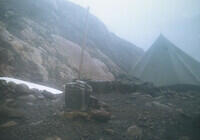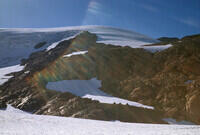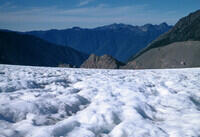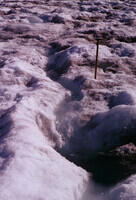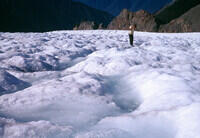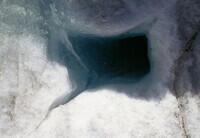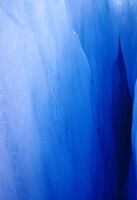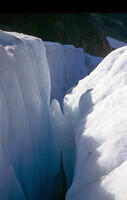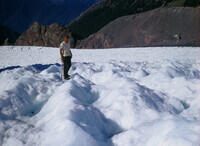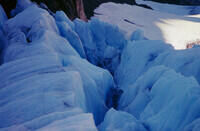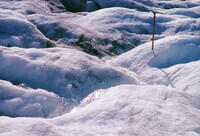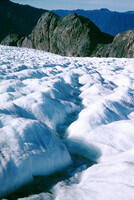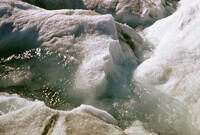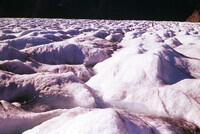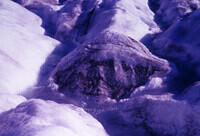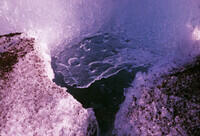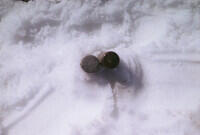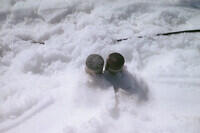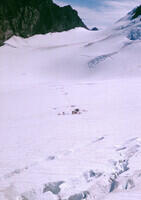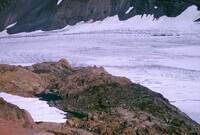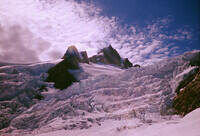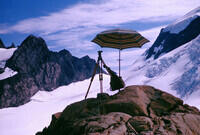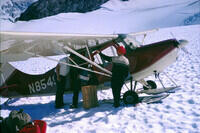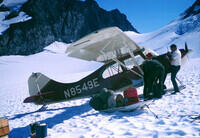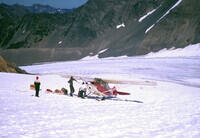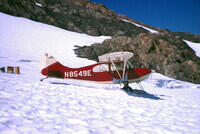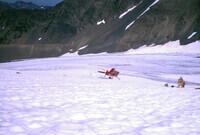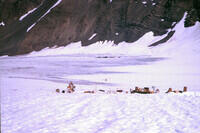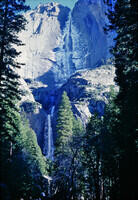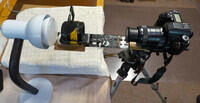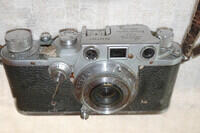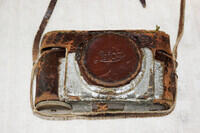RETURN TO PREVIOUS INDEX
During the summers of 1967 and 1969, after my freshman and junior years at UCSD, I worked on glaciology projects under Dr. Barklay Kamb of Caltech. The goal was to study the flow of the ice over bedrock. The studies were done on the Blue Glacier on the side of Mt. Olympus in the Olympic National Park in the state of Washington.
In 1967, we dug a tunnel horizontally in an ice fall to try to reach bedrock, taking advantage of the steep angle of the glacier at that location. This was a joint project with a University of Washington team led by Ed LaChapelle and including Will Harrison. The tunnel was dug with the help of chain saws, jack hammers, and ice picks. We reached a region with lots of rock in the ice, but I'm not convinced that we were actually at bedrock. Any relative motion was very small. I'm having trouble remembering the length of the tunnel or finding any records, but it was well over 100 ft. About a third of the way from the end, we dug at nearly right angles to the left trying to identify the cavity that had been causing reverberations while digging. We had not gone far when we hit a huge cavern between the ice and the mountain. I believe we could have climbed out from under the glacier along its side via that cavity. Instead of subtle melting and refreezing as the ice flowed over rock obstructions, the ice peeled off in big "jelly rolls".
In 1969, Barklay wanted to study the flow over bedrock in a somewhat less dramatic setting, down on the much flatter part of the glacier. A tunnel was not practical because of both the angle (a downhill tunnel might fill with water) and the thickness. So we used hotpoints (powered by an electric generator) about three inches in diameter to melt bore holes through the ice. The idea was to melt one hole all the way to bedrock. Then melt another to within about a foot of bedrock next to it (depth predicted from the first hole). Then melt a narrow hole the rest of the way to bedrock at the bottom of the second hole. The speed of the flow would be determined by photography of the rocks going by in the first hole. The relative importance of melting/refreezing vs deformation would be determined by changes in lengh of the small hole. We had several pairs of holes. The hitch was that the bottom meter or more of ice was full of silt and rock which insulated the tips of the hotpoints. We ended up melting large cavities at the bottom of the holes when the hotpoints slowed down drastically. The photography still worked and we got speed measurements, but the small hole scheme did not work as I recall.
The hotpoints were at the end of a pipe roughly 2m long. While preparing to lower the assembly, there was a short time after lining up the pipe in the hole and before the cables were attached when it was possible for the assembly to slip out of ones grip and fall, untethered, into the hole. That generally meant the hole was blocked and the hotpoint was lost, which was not good because they were not cheap. I did that one day. Barclay wasn't happy and I was quite annoyed at myself. But I managed to cobble together a Rube Goldberg device with nails, rubber bands big washers and other items in our supplies that could grab the top of the pipe by sticking nails into the hex holes of the set screws holding the cable connectors to the top. After much testing with an extra hotpoint, I tried it on the one at the bottom of the hole. After several tries, it worked! Barclay was quite interested in my device after I pulled up the lost hotpoint.
One of the other people working on the project in 1969 was Steve Russell, a friend of mine from UCSD. During both summers, we had an occasional day off (one per week, as I recall). We would usually use that day to climb nearby peaks or explore glaciers in other valleys. On one day, Steve and I used the time to explore the lower part of the Blue Glacier where the bare ice was exposed. Our work areas were in the accumulation zones where the top layers were the previous winter's snow accumulation. We did not leave the mountain during either summer so we were pretty isolated for the month in 1967 and 3 months in 1969. Our reintroduction to civilization was somewhat cushioned by the fact that the first people we ran into in 1967, at a camp just off the glacier, were celebrating Bilbo Baggins' birthday.
There is a hut on the Snow Dome on the side of Mt. Olympus, near the top of the Blue Glacier, that is used to support glaciology on the mountain. That is where we stayed the first summer. Each day we would hike (actuall glassade most of the way) down to the ice fall work area. At the end of the day, we would trudge back up. It was about an 700 ft elevation difference. There were a total of 11 people there the first summer. The second summer, Barklay's team, which was now something like 5 or 6 people, camped on a moraine along the side of the glacier much closer to the work area. That avoided a lot of time getting back and forth to the work sites. During both seasons, supplies were flown in by ski plane. Several flights were required to start the season, then there was a flight about once a week.
There was a major event in the outside world during the 1969 season - the first Moon landing. A television was flown in to the hut by the University of Washington crew at the Snow Dome to allow both crews to see the landing. For this, we took, as I recall, 3 days off to hike up to the cabin and watch the coverage of the landing and the Moon walk. Barklay was not too happy about the lost time, but did not prevent it and did join us for the crucial few hours. This was something the rest of us really did not want to miss. There is a photo in this set of the Moon over Mt. Olympus taken during the time Armstrong and Aldrin were on the surface.
The photos here were taken with a WWII vintage Leica rangefinder camera that my father, from what I heard, acquired from one of the first American soldiers to reach the Leica factory. Its serial number indicates it was made in the final months of the war. It had a light leak that I had pretty well sealed, but still shows up barely in a couple of the photos. This is a quality but basic camera. You can get an idea of all the available functions from the fact that it does not have a battery so there isn't even a light meter. It also has a fixed focal 50 mm lens. Some of the photos suggest I had another focal length available, but I forget how. There are pictures of the camera and its case, which I still have, as they are in October 2025, at the end of the show. They have had a rough life.
The film was Kodachrome II, whose archival qualities allow the photos digitized in 2025, nearly 60 years after they were taken, to look little different than they would have if they were taken yesterday. I digitized the photos using my Pentax K5 DSLR, a 100mm Macro lens, a slide holder and frosted glass from a film era slide duplicator, and a desk lamp with an LED bulb with adjustable color temperature. The setup is shown in a photo at the end of this set. I used the Gimp to crop the images, tweak the color balance and get rid of the occasional offensive piece of dust. With all the snow, the results are very sensitive to color balance.
I have identified the locations of many photos by comparison with Google Earth, using the ability to pan around and zoom in and out to try to duplicate backgrounds.
I found a reference to a paper that may be for the 1967 work, but I have not located a copy I can read: Kamb, B., E. R. LaChapelle, Flow dynamics and structure in a fast-moving icefall, Trans. AGU, 49, 312, 1968.
A picture from the project is at: https://www.semanticscholar.org/paper/Classics-in-physical-geography-revisited-Knight/0a8a67ac8930b73857544cb66c3e3d6c22c1e226/figure/1
DIGITIZATION SETUP AND CAMERA
